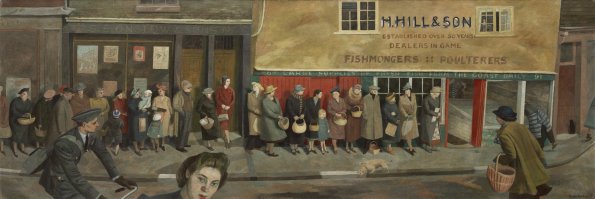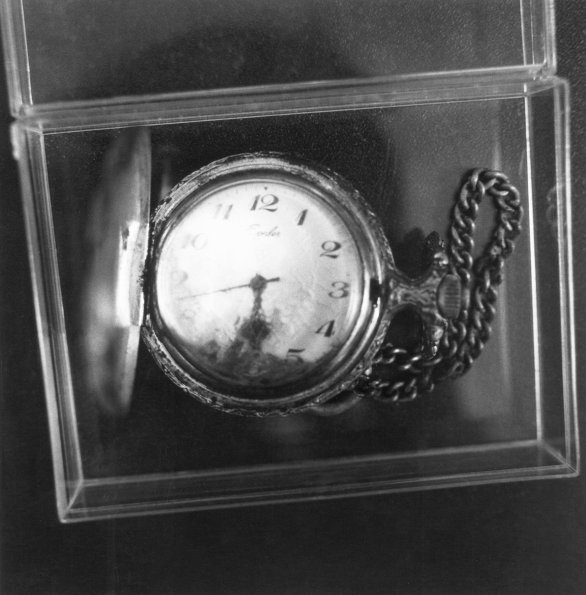Women War Artists, Imperial War Museum, London | reviews, news & interviews
Women War Artists, Imperial War Museum, London
Women War Artists, Imperial War Museum, London
Compelling and imaginative responses to war by female artists
The sturdy, healthy, almost glowing attractiveness of Ruby Loftus, her reddish curls partly tamed by a green hair net, her face punctuated by bright-red lipstick characteristic of the 1940s, her blue overall neatly complementing her red shirt, and her expression intense and concentrated as she screws a breech ring as part of the manufacture of the Bofors gun at a factory in Newport, is a famously captivating image of the Home Front in the last world war.
Dame Laura Knight’s painting Ruby Loftus Screwing a Breech-Ring, 1943 (main picture), a portrait of the young woman choreographed among her peers on the factory floor, is one of the utterly absorbing elements of an exhibition that raises as many questions as it answers: is there a specific vantage point that female eyewitnesses bring to the depiction of conflict? And is their view less macho, less brutal than their male reportorial counterparts? Can you tell from the result the gender of the hand wielding the brush, the pen, the camera?
Certainly on display there is an imaginative variety of responses to conflict, uncertainty, fear, distress and the hard work of just plain getting on with it that are all characteristics of Britain’s involvement in the wars of the 20th century. Why culturally segregate by gender? Aren’t we meritocratic, equal and excellent in achievement? I think this show does indicate that even now there are unavoidable cultural differences: yes, equal but different.
There are several layers to this excellent and succinct compilation, due to the unique nature of the museum. First, the Imperial War Museum is not a museum for the centuries: its remit begins with the 20th century and it is the nearest to a complete historical museum of the period that we have in the UK. The IWM is home to the second largest collection of 20th and 21st-century British art in the country, only eclipsed by Tate Britain.
The art in all media has been collected from a variety of sources with a significant part commissioned by various specialist committees and commissions initiating official war art: thus Linda Kitson, the first woman to be nominated by the IWM’s Artistic Records Committee and embedded with the Falklands Task Force along with 3,000 men on board the Queen Elizabeth II as it travelled in the sub-zero weather in the South Atlantic. Kitson is a draughtswoman, a narrator, and her spiky and very lively black-and-white sketches of burning ships and groups of the military are high-level reportage.
 There are affecting mundane vignettes of the oddities of daily life away from the action, including Olive Mudie-Cooke’s atmospheric view of a couple in an ambulance in the First World War: a uniformed female volunteer auxiliary lighting a cigarette for a patient, the soldier under his blanket in full military uniform, including his cap. Another drawing, Burnt Out Tank, is far less cosy and more overtly surreal.
There are affecting mundane vignettes of the oddities of daily life away from the action, including Olive Mudie-Cooke’s atmospheric view of a couple in an ambulance in the First World War: a uniformed female volunteer auxiliary lighting a cigarette for a patient, the soldier under his blanket in full military uniform, including his cap. Another drawing, Burnt Out Tank, is far less cosy and more overtly surreal.
Both world wars meant huge leaps in professional and perhaps emotional liberation for women at home and beyond, although there was still a glass ceiling, with the senior and most skilled jobs male prerogatives. And this anthology does still emphasise some of the cultural values which might be considered feminine, if not feminist. There is surprisingly little sentimentality, but a certain amount of understated heroism, not so much under fire, but just the stoicism of keeping things going. Evelyn Dunbar shows us a subtly monumental study of a land girl and a bull and some cows in the muted English countryside, as well as a London scene of the queue at the fish shop in 1944 (pictured above).
 Beauty out of horror is, as always, a puzzling ambiguity. The artists are eyewitnesses, commentators, too, in their choice of subject sometimes foisted on them. The most disturbing and distressing perhaps is a sequence of photographs in a portfolio called Kosovo Series by the German photographer Frauke Eigen. The understated black-and-white images show ordinary bits of clothing and things: a vest, watch (pictured right), pullover, a set of keys, taken and separated from the bodies of women and children exhumed from a mass grave. The massacre extinguished lives but not the domestic objects that were part of those lives.
Beauty out of horror is, as always, a puzzling ambiguity. The artists are eyewitnesses, commentators, too, in their choice of subject sometimes foisted on them. The most disturbing and distressing perhaps is a sequence of photographs in a portfolio called Kosovo Series by the German photographer Frauke Eigen. The understated black-and-white images show ordinary bits of clothing and things: a vest, watch (pictured right), pullover, a set of keys, taken and separated from the bodies of women and children exhumed from a mass grave. The massacre extinguished lives but not the domestic objects that were part of those lives.
There is hope here, too: life going on, scenes of evacuations of children, workers camouflaging a ship, arriving at factories, and the survivors of Belsen being tenderly washed and cared for in a vast ward by Doris Zinkeisen in 1945. Finally, there is the strange queer beauty of ruins: Hamburg in red crayon by Mary Kessell, and twisted girders in Bristol by the avant-garde artist Paule Vezelay.
- Women War Artists at the Imperial War Museum London, until 27 November
 Find Women War Artists by Kathleen Palmer on Amazon
Find Women War Artists by Kathleen Palmer on Amazon
Share this article
more Visual arts
 Jane Harris: Ellipse, Frac Nouvelle-Aquitaine MÉCA, Bordeaux review - ovals to the fore
Persistence and conviction in the works of the late English painter
Jane Harris: Ellipse, Frac Nouvelle-Aquitaine MÉCA, Bordeaux review - ovals to the fore
Persistence and conviction in the works of the late English painter
 Sargent and Fashion, Tate Britain review - portraiture as a performance
London’s elite posing dressed up to the nines
Sargent and Fashion, Tate Britain review - portraiture as a performance
London’s elite posing dressed up to the nines
 Zineb Sedira: Dreams Have No Titles, Whitechapel Gallery review - a disorientating mix of fact and fiction
An exhibition that begs the question 'What and where is home?'
Zineb Sedira: Dreams Have No Titles, Whitechapel Gallery review - a disorientating mix of fact and fiction
An exhibition that begs the question 'What and where is home?'
 Yoko Ono: Music of the Mind, Tate Modern review - a fitting celebration of the early years
Acknowledgement as a major avant garde artist comes at 90
Yoko Ono: Music of the Mind, Tate Modern review - a fitting celebration of the early years
Acknowledgement as a major avant garde artist comes at 90
 Unravel: The Power and Politics of Textiles in Art, Barbican review - the fabric of dissent
An ambitious exploration of a neglected medium
Unravel: The Power and Politics of Textiles in Art, Barbican review - the fabric of dissent
An ambitious exploration of a neglected medium
 When Forms Come Alive, Hayward Gallery review - how to reduce good art to family fun
Seriously good sculptures presented as little more than playthings or jokes
When Forms Come Alive, Hayward Gallery review - how to reduce good art to family fun
Seriously good sculptures presented as little more than playthings or jokes
 Entangled Pasts 1768-now, Royal Academy review - an institution exploring its racist past
After a long, slow journey from invisibility to agency, black people finally get a look in
Entangled Pasts 1768-now, Royal Academy review - an institution exploring its racist past
After a long, slow journey from invisibility to agency, black people finally get a look in
 Barbara Kruger, Serpentine Gallery review - clever, funny and chilling installations
Exploring the lies, deceptions and hyperbole used to cajole, bully and manipulate us
Barbara Kruger, Serpentine Gallery review - clever, funny and chilling installations
Exploring the lies, deceptions and hyperbole used to cajole, bully and manipulate us
 Richard Dorment: Warhol After Warhol review - beyond criticism
A venerable art critic reflects on the darkest hearts of our aesthetic market
Richard Dorment: Warhol After Warhol review - beyond criticism
A venerable art critic reflects on the darkest hearts of our aesthetic market
 Dineo Seshee Raisibe Bopape: (ka) pheko ye / the dream to come, Kiasma, Helsinki review - psychic archaeology
The South African artist evokes the Finnish landscape in a multisensory installation
Dineo Seshee Raisibe Bopape: (ka) pheko ye / the dream to come, Kiasma, Helsinki review - psychic archaeology
The South African artist evokes the Finnish landscape in a multisensory installation
 Paul Cocksedge: Coalescence, Old Royal Naval College review - all that glitters
An installation explores the origins of a Baroque masterpiece
Paul Cocksedge: Coalescence, Old Royal Naval College review - all that glitters
An installation explores the origins of a Baroque masterpiece
 Issy Wood, Study for No, Lafayette Anticipations, Paris review - too close for comfort?
One of Britain's most captivating young artists makes a big splash in Paris
Issy Wood, Study for No, Lafayette Anticipations, Paris review - too close for comfort?
One of Britain's most captivating young artists makes a big splash in Paris

Add comment